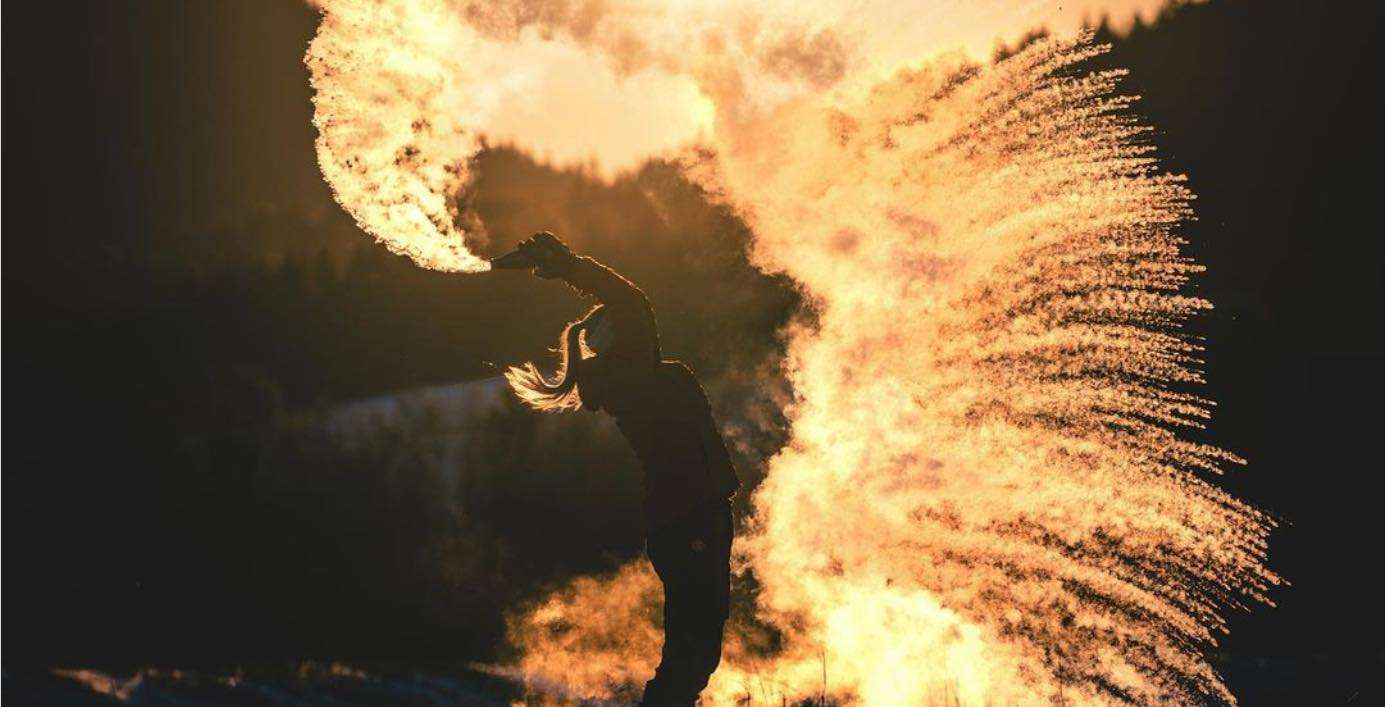With Lamb, Coriander, and Leeks, These Decoded Babylonian Recipes Reveal Ancient Culinary Traditions
4 recipes for stews have been decoded from ancient Babylonian tablets contained within Yale's collection, and made cookable again by scholars.

Every winter, awesome photos and videos show up on social feeds as people try to make the most of the cold weather—by turning boiling water into amazing ice crystals.
How does hot water turn into frozen clouds when it's cold?
According to National Geographic, this phenomenon occurs because boiling water is already so close to evaporating: "Because they're so hot, those tiny water droplets start to vaporize. But since cold air can't hold as much water vapor as warmer air, the water condenses. Extremely cold temperatures quickly freeze the water droplets, which fall as ice crystals."
Perfect weather 2 have some cold weather fun. The #mpemba effect is pretty cool science experiment where the cold weather will actually freeze Boiling water instantly when thrown in the air. Try this with cold water and well you just get soaked. #weather #science #polarvortex pic.twitter.com/NwlJ3VzcWX
— Craig Boehm (@Skstormchaser) February 6, 2021
Perfect weather 2 have some cold weather fun. The #mpemba effect is pretty cool science experiment where the cold weather will actually freeze Boiling water instantly when thrown in the air. Try this with cold water and well you just get soaked. #weather #science #polarvortex pic.twitter.com/NwlJ3VzcWX
Want to take such a video or image yourself? With the polar vortex bringing frigid temperatures to much of the Northern Hemisphere this week, now is as good a chance as any to try.
Saying that, it must be properly cold where you are: as in 14°F/-26°C or below. Really, don't attempt this if the wind is blowing towards you. And try throwing the water away from you before throwing boiling water above your head.
If the wind and weather is happily in your favor? Head out with a large flask of boiling water into a place with few visual distractions—such as a low field. If it's Golden Hour, which happens around sunset or sunrise, the light should be glowy and perfect.
Now find a spot that looks towards the sun and have your model throw the hot water towards its rays.
If you have a wide angle lens, do use it. If you just have a smartphone: that's good too. Just standing a little far back so you can get the full ice-crystal effect in the frame. Have your model do a few takes, and voila. Hopefully you got your dream shot.
How does hot water turn into frozen clouds when it's cold?
According to National Geographic, this phenomenon occurs because boiling water is already so close to evaporating: "Because they're so hot, those tiny water droplets start to vaporize. But since cold air can't hold as much water vapor as warmer air, the water condenses. Extremely cold temperatures quickly freeze the water droplets, which fall as ice crystals."
Perfect weather 2 have some cold weather fun. The #mpemba effect is pretty cool science experiment where the cold weather will actually freeze Boiling water instantly when thrown in the air. Try this with cold water and well you just get soaked. #weather #science #polarvortex pic.twitter.com/NwlJ3VzcWX
— Craig Boehm (@Skstormchaser) February 6, 2021
Perfect weather 2 have some cold weather fun. The #mpemba effect is pretty cool science experiment where the cold weather will actually freeze Boiling water instantly when thrown in the air. Try this with cold water and well you just get soaked. #weather #science #polarvortex pic.twitter.com/NwlJ3VzcWX
Want to take such a video or image yourself? With the polar vortex bringing frigid temperatures to much of the Northern Hemisphere this week, now is as good a chance as any to try.
Saying that, it must be properly cold where you are: as in 14°F/-26°C or below. Really, don't attempt this if the wind is blowing towards you. And try throwing the water away from you before throwing boiling water above your head.
If the wind and weather is happily in your favor? Head out with a large flask of boiling water into a place with few visual distractions—such as a low field. If it's Golden Hour, which happens around sunset or sunrise, the light should be glowy and perfect.
Now find a spot that looks towards the sun and have your model throw the hot water towards its rays.
If you have a wide angle lens, do use it. If you just have a smartphone: that's good too. Just standing a little far back so you can get the full ice-crystal effect in the frame. Have your model do a few takes, and voila. Hopefully you got your dream shot.
For some inspiration: Haven't these Instagrammers from around the world made shooting what's known as the ‘Mpemba effect‘ look easy?
A post shared by Kasper M. de Thurah (@iamnordic)
A post shared by Aleksej Kucheryavenko (@aleksejkucheryavenko)
A post shared by 𝒫𝒶𝓉𝓇𝒾𝓏𝒾𝒶 (@p.a.t.r.i.z.i.a.88)
A post shared by Céline • Je Papote (@jepapote)
A post shared by anJa kaLan (@anjakalan)
A post shared by Max Strelkov - Finnish stories (@maximstrelkov)
Featured image: @iamnordic/Instagram
SHARE the Photographic Art and Send This Story to Friends…
Be the first to comment